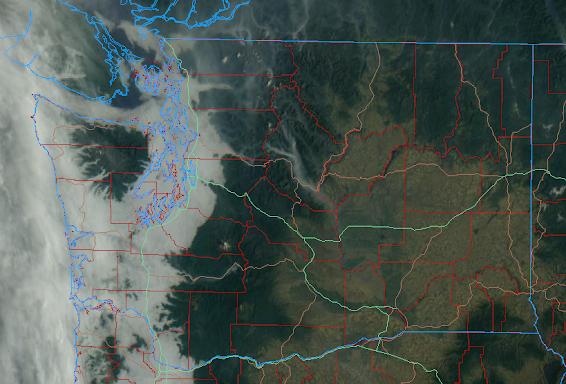It’s the end of October, and while there are still a few active fires, it looks like the rain is here to stay. We wanted to review the most recent smoke event and put this wildfire season into context in comparison with previous years.
Ecology's Air Monitoring Coordinator, Jill Schulte, put together these useful maps to look at the frequency and duration of smoke events. She used the daily Hazard Mapping System (HMS) smoke polygons developed by the National Oceanic and Atmospheric Administration’s (NOAA’s) Office of Satellite and Product Operations.
These polygons use daily GOES satellite imagery to categorize the density of smoke as light, medium, or heavy. Polygons categorized as heavy are more likely to indicate the presence of ground-level smoke. To make these maps, the daily heavy HMS smoke polygons during wildfire season were overlaid with 4km grid cells, and the number of days each grid cell intersected (at any part of the grid cell) a heavy smoke polygon were counted.
The first map below shows the average number of heavy wildfire smoke days from 2015-2021—you can really see how different parts of the state have been impacted by wildfire smoke over the years, with some locations experiencing on average over 20 days of wildfire smoke per year.
The second map below describes the number of heavy wildfire days just in 2022—you can easily identify the locations of the active fires that led to prolonged smoke impacts in western and central WA.
So how did 2022 measure up?
Another way to put this wildfire season into context is to look at how many Washingtonians were exposed to extended periods of unhealthy air in comparison to other recent smoke events.
The number of people exposed to unhealthy or worse air quality (daily PM2.5 average of > 55 micrograms per cubic meter) in 2022 is comparable to the smoke-filled days of 2017, 2018, and 2020.
One difference between 2022 and previous years is the duration of the smoke event. While the smoke lingered for much longer than we hoped this year, the majority of Washingtonians were exposed to unhealthy or worse air for less than 5 days. A smaller fraction of the state (those located closest to active fires including the areas of Darrington, Leavenworth, and Wenatchee) were exposed to unhealthy or worse air for 10-14 days.
And finally we can take a look at an updated PM2.5 cumulative exposure plot. Last we checked in early October, average statewide concentrations in 2022 were middling compared to those of the last 10 years. A week of heavy smoke makes an impact—an updated analysis below shows that average statewide PM2.5 concentrations are greater than most years in the past decade. Average cumulative 2022 PM2.5 concentrations as of 10/25/2022 are only less than 2017, 2018, and 2020—years with larger fires or smoke that blanketed the entire state for weeks.
















